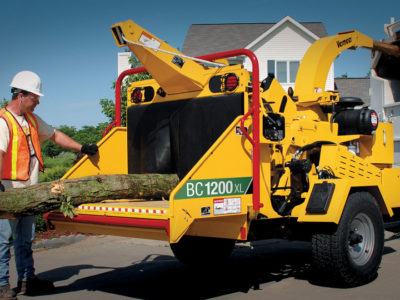When you think about safety, what comes to mind? Maybe it’s in regard to your crew, your tree care equipment or the jobsite. Whatever your thoughts may be, safety should be a main priority on the jobsite. To help keep safety top of mind while operating your brush chipper, check out these six tips and videos.
Trailer and transport
One important element to consider with your brush chipper is proper trailering and transport of your brush chipper. What is the right way to transport it, and what should you check each time before you transport it? On top of following all commercial transport operation requirements and DOT guidelines, you’ll also want to make sure you’re performing and documenting pre-trip and post-trip inspections on your brush chipper. To help give you an idea of what you should inspect and check each time, watch the video below.
Operator’s and maintenance manuals
Your machine’s operator’s and maintenance manuals instruct you how to properly operate and maintain your brush chipper. They detail out the unique features of your machine and how to operate day to day. To get a better grasp on how to use these manuals, watch the video below.
Rope and line hazards
Another area where tree care professionals can implement safety practices is with potential rope and line hazards. Never allow ropes or lines in a brush chipper work area. To help avoid hazards, keep the jobsite away from the brush chipper work area, Watch the video for more information on rope and line hazards.
Feeding issues
If you’ve operated brush chippers for an extended period of time, you know that every now and then there can be feeding issues. To help you resolve those issues, you should know how to properly shut down your machine and follow lockout, tag-out procedures. Make sure you remove the key in the brush chipper before you attempt to clear a clogged chip chute or an infeed jam. Beyond that, there are few other procedures you should make sure you’re following when resolving a feeding issue. The video below will walk you through those.
Jobsite setup
Before you begin chipping, you can set yourself up for success by setting up the jobsite appropriately. For example, you should place cones and signs around the equipment if you’re by a street and wear high-visibility reflective vests or shirts. On top of that, there’s the required personal protection equipment (PPE) that you should always be wearing. When it comes to using a brush chipper, there are additional specific steps you should take to prepare your jobsite. Watch the video below to learn more about them.
Winch control
How comfortable are you when using a winch? Do you know how to operate the winch controls and know what each control does? If you aren’t sure, then it’s time to brush up on the proper way to operate it by referring to your machine’s operator’s manual. There are also several helpful tips, like standing clear of the winch line path during pulling and making sure the winch lines don’t get tangled in brush or material that’s being fed into the machine. For more tips, check out the video below.
Be sure to follow all the necessary procedures while operating your brush chipper on the jobsite. For more information, check out the operator’s manual for your specific brush chipper, or contact your local dealer if you have any questions.
Always refer to the product’s maintenance and/or service manual for safety messages and further instructions.
Vermeer Corporation reserves the right to make changes in engineering, design and specifications; add improvements; or discontinue manufacturing at any time without notice or obligation. Equipment shown is for illustrative purposes only and may display optional accessories or components specific to their global region. Please contact your local Vermeer dealer for more information on machine specifications.
Vermeer and the Vermeer logo are trademarks of Vermeer Manufacturing Company in the U.S. and/or other countries.
© 2021 Vermeer Corporation. All Rights Reserved.
